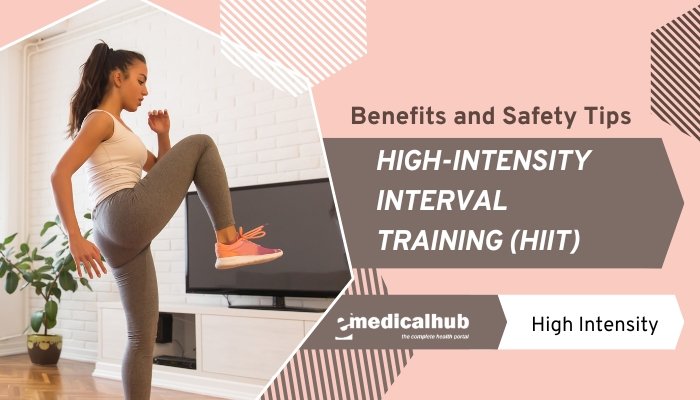Introduction
Amid busy lifestyles and the desire for efficient workouts, High-Intensity Interval Training (HIIT) has surged in popularity. Known for its short, intense bursts of exercise interspersed with rest or lower-intensity recovery, HIIT promises to deliver robust cardiovascular and metabolic benefits without requiring hours in the gym.
From elite athletes seeking a performance edge to everyday people looking for faster results, HIIT’s appeal lies in time efficiency and a calorie-torching reputation. But is it suitable for everyone? And how can you ensure you’re performing it safely?
This article unpacks the science behind HIIT, examines its proven benefits—from improved cardiovascular health to boosted metabolism—and offers best practices for structuring safe and effective sessions.
Whether you’re new to fitness or an experienced exerciser curious about upgrading your routine, understanding HIIT can help you leverage intense intervals for optimal results.
Disclaimer: The following content is for educational purposes only. If you have underlying health conditions, a history of injury, or are new to exercise, consult a medical professional before starting any new workout regimen, including HIIT.
What Is HIIT?
Defining High-Intensity Interval Training
HIIT involves alternating between short bursts (e.g., 20–60 seconds) of near-maximal or maximal effort and lower-intensity “active rest” or complete rest (e.g., 30–90 seconds). Typically, total workout durations range from 10–30 minutes, reflecting the elevated effort level. Examples include:
- Sprinting vs. Walking: 30 seconds of sprinting, 60 seconds of walking, repeated for a set number of rounds.
- Cycling Intervals: 20 seconds of pedaling at maximum speed, 40 seconds at a comfortable pace.
- Bodyweight Circuits: Explosive moves (burpees, jump squats) followed by low-intensity steps or rest.
Key idea: Push close to your top threshold, then allow partial recovery, repeating multiple times.
How It Differs from Steady-State Cardio
Steady-state cardio (like a moderate 30-minute jog) keeps intensity relatively constant. HIIT, by contrast, has:
- Higher Peak Intensity: Reaching near 80–90% of maximal heart rate (or even higher).
- Intervals and Variation: Heart rate fluctuates between near-peak and recovery zones.
- Shorter Overall Duration: Because intervals are tough, sessions can be significantly briefer than typical steady endurance runs or cycles.
This structure can yield benefits for cardiovascular fitness and calorie burn in less time, albeit at higher perceived exertion.
Benefits of HIIT
Time Efficiency
One of HIIT’s biggest draws:
- Short Workouts: Workouts can be completed in 20 minutes or less while still offering significant aerobic and anaerobic gains.
- Ideal for Busy Schedules: Instead of an hour-long gym session, 2–3 HIIT workouts per week might maintain or improve fitness levels effectively.
For individuals balancing family, work, or other commitments, HIIT’s brevity can boost workout adherence.
Enhanced Calorie Burn and EPOC
Excess Post-Exercise Oxygen Consumption (EPOC)—often called the “afterburn effect”—indicates an elevated metabolic rate post-workout:
- Intense Intervals demand quick energy from anaerobic metabolism, causing a metabolic disturbance that the body must correct.
- Higher Oxygen Demand During Recovery leads to more calorie burn for hours post-HIIT compared to moderate continuous exercise.
While the exact EPOC effect can be modest, it can add up over multiple sessions, aiding weight management.
Improved Cardiovascular and Metabolic Health
Studies show that HIIT may:
- Boost VO₂max (a key measure of aerobic capacity) more than moderate-intensity steady-state training in some individuals.
- Enhance Insulin Sensitivity: Intervals help cells uptake glucose more efficiently, beneficial for prediabetes or type 2 diabetes.
- Reduce Blood Pressure: Intermittent high-intensity can promote arterial elasticity and other beneficial vascular adaptations.
Muscle Preservation and Strength Gains
While not a pure strength protocol, certain HIIT routines with bodyweight or resistance-based intervals (e.g., squat jumps, push-ups, kettlebell swings) can help preserve or build lean muscle. The short rest intervals also challenge fast-twitch muscle fibers, fostering power development alongside endurance.
Safety Considerations and Potential Risks
High Intensity = Elevated Injury Risk
Pushing close to maximal effort can be demanding:
- Muscle Strains or Sprains: Rapid, explosive moves might stress joints or muscles, especially if form is compromised by fatigue.
- Cardiovascular Strain: If you have heart conditions or are new to intense exercise, going all-out might be risky. A medical check-up is wise if uncertain.
- Proper Progression: Jumping straight from inactivity to intense intervals can shock the system. Gradual increments in intensity and volume are crucial.
Overtraining and Insufficient Recovery
HIIT can be quite taxing:
- CNS Fatigue: Repeated high-intensity sessions with short recovery windows can lead to burnout, poor sleep, or mood changes.
- Muscle Soreness: Lactic acid buildup and microtears in muscle tissues require rest or active recovery days to heal.
- Limit to 2–3 Sessions/Week: Typically recommended to prevent chronic overuse.
Form and Technique
When performing dynamic exercises (like plyometric jumps or sprints):
- Focus on proper biomechanics: E.g., landing softly in jump squats to reduce impact.
- Progress from simpler to advanced: Start with safe motions (like walking intervals) or less plyometric load before advanced bounding or sprinting.
Getting Started with HIIT
Prerequisites
- Baseline Fitness: Some level of cardiovascular conditioning can help mitigate immediate exhaustion or risk. Beginners can do modified intervals (lower intensities or shorter intervals).
- Warm-Up: A thorough 5–10 min dynamic warm-up (light jogging, mobility drills) readies muscles and reduces injury risk.
- Clear Goals: Are you focusing on fat loss, improved cardio, or quick workouts? Tailoring intervals to the objective fosters better structure.
Structuring an HIIT Session
- Warm-Up: Light cardio + dynamic stretches (3–5 minutes).
- Interval Rounds: For instance, 20 seconds all-out effort, 40 seconds active rest, repeated 6–8 times. Alternatively, 30/30 or 45/15 splits.
- Variety in Exercises: Could be sprints, cycling, rower, or bodyweight moves.
- Cool-Down: Gentle walk or static stretches (3–5 minutes) to bring heart rate down gradually.
Sample Workouts
Example 1: Beginner Treadmill
- Warm-up: 5 min easy walk
- Intervals (x5–8 sets): 20 sec moderate jog (RPE ~7/10), 40 sec easy walk
- Cool-down: 3 min slow walk + calf/hamstring stretching
Example 2: Bodyweight Circuit
- Warm-up: Light jumping jacks, shoulder rolls
- Work 30 seconds: Jump squats or high knees → Rest 30 seconds (walking in place)
- Work 30 seconds: Mountain climbers → Rest 30 seconds
- Repeat circuit 4 times
- Cool-down: Hip flexor, quad stretch
Example 3: Advanced Sprints
- Warm-up: Dynamic drills (leg swings, butt kicks)
- Intervals (6 sets): 15–20 sec full sprint, 60 sec slow jog/walk
- Cool-down: easy jog + static stretch
Best Practices for Maximizing Results
Monitor Intensity
- Heart Rate: Many aim for 80–90% of max HR during work intervals. Alternatively, use RPE (rate of perceived exertion), striving for 8–9 on a 1–10 scale.
- Power Output: If using a bike or rower, watch wattage or speed to gauge consistent intensity each interval.
Gradual Progression
- Increase Interval Duration: E.g., from 15-second sprints to 20 seconds over weeks.
- Reduce Rest Time: Another method to heighten challenge—2:1 ratio might shift to 3:1 as you improve.
- Introduce Variation: Weighted intervals, different cardio equipment, or mix up intervals to avoid plateaus.
Nutrition and Hydration
- Pre-Workout Fuel: Light carbs + protein an hour or so prior, especially if performing in the morning.
- Post-Workout: Replenish with balanced meals containing carbs, protein, and possibly antioxidants to aid recovery.
- Stay Hydrated: High-intensity sweats can be significant; water or an electrolyte solution might be needed.
Listen to Body Signals
- Fatigue or Joint Pain: Indicate you may need extra rest or less frequent HIIT.
- DOMS: Some soreness is normal, but intense or persistent pain suggests overreaching or poor technique.
- Adaptation: If you can’t push your intervals because of constant fatigue, reevaluate frequency or intensity.
Frequently Asked Questions (FAQ)
- How often can I do HIIT each week?
Typically, 2–3 times per week is recommended. More frequent sessions risk overtraining or diminishing returns, unless you’re varying intensities or are highly trained. - Will HIIT burn more fat than steady-state cardio?
Some studies show that HIIT can produce comparable or sometimes higher fat oxidation over time. Yet the difference might not be massive. What matters is total caloric burn, consistency, and overall diet. Both can be effective. - Can beginners try HIIT?
Yes, but start gently—short intervals at moderate intensity. For instance, 15 seconds of faster walking and 45 seconds easy pace, progress gradually. Checking with a doctor if you’re sedentary or have medical issues is wise. - Should I do HIIT on an empty stomach?
This depends on personal preference. Fasted HIIT may work for some, but others risk early fatigue or dizziness. If you feel weak, a light snack with carbs might help performance. - Does HIIT lead to muscle loss since it’s cardio-based?
Not necessarily. With adequate protein intake and occasional strength training, you can maintain or even build muscle. Some HIIT routines incorporate resistance moves that challenge muscles effectively.
Conclusion
For those pressed for time or seeking a potent, time-efficient approach to fitness, High-Intensity Interval Training (HIIT) can be an excellent solution. By alternating intense bursts of effort with brief rest or lower-intensity phases, HIIT stimulates both aerobic and anaerobic systems, potentially offering enhanced metabolic rate, improved cardio capacity, and beneficial hormone responses. Studies show it can help with weight management, boosting insulin sensitivity and promoting fat loss while preserving muscle mass.
However, the benefits come with caution: the very intensity that makes HIIT effective can increase injury risk or strain if done too frequently or without proper form. Ensuring a structured approach—adequate warm-up, progressive increments in interval difficulty, and mindful scheduling of rest days—helps avoid pitfalls like overtraining, joint stress, or burnout. Combined with a sensible diet and other forms of exercise (like steady-state cardio or resistance training), HIIT stands as a powerful tool in a well-rounded fitness program. Embrace short, purposeful workouts to achieve significant gains in less time—but approach the challenge with knowledge, caution, and attentiveness to your body’s signals.
References
- Gibala MJ, Little JP, Macdonald MJ, Hawley JA. Physiological adaptations to low-volume, high-intensity interval training. J Physiol. 2012;590(5):1077-1084.
- Weston M, Taylor KL, Batterham AM, et al. Effects of low-volume high-intensity interval training on fitness in adults. Med Sci Sports Exerc. 2014;46(8):1481-1487.
- Tjønna AE, et al. Aerobic interval training vs. continuous moderate exercise in metabolic syndrome. Circulation. 2008;118(4):346-54.
- Jung ME, Bourne JE, Little JP. High-intensity interval exercise training in overweight and obese adults. J Obes. 2015; 2015: 789156.
- Alkahtani SA. Comparing interval training with continuous moderate exercise for fat burning. J Hum Kinet. 2014; 43:155-67.
- Laursen PB, Jenkins DG. The scientific basis for high-intensity interval training: optimizing training programmes. Sports Med. 2002;32(1):53-73.
- Jelleyman C, Yates T, O’Donovan G, et al. The effects of high-intensity interval training on glucose regulation and insulin resistance. Obes Rev. 2015;16(11):942-61.
- Sloth M, Sloth D, Overgaard K, et al. Effects of sprint interval training on body composition. Scand J Med Sci Sports. 2013;23(6):e32-41.
- ACSM. High-Intensity Interval Training (HIIT) Fact Sheet. 2020.
- Bartlett JD, Close GL, MacLaren DP, et al. High-intensity interval running training. Int J Sports Med. 2011;32(2):96-103.
- Lunt H, Draper N, Marshall HC, et al. High intensity interval training in a real-world setting. BMJ Open Sport Exerc Med. 2014;2(1):e000219.
- Keating SE, Johnson NA, Mielke GI, et al. A systematic review and meta-analysis of interval training vs. continuous training for body fat mass. Obes Rev. 2017;18(8):943-964.





